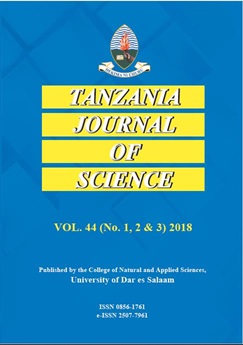Mineralogical and Physicomechanical Characterization of Kaolinitic Clay from Moshi, Northern Tanzania for Potential Ceramic Utilization
DOI:
https://doi.org/10.4314/tjs.v48i4.19Abstract
Kaolin clay from Moshi, northern Tanzania has been characterized for potential ceramics productions. Clay samples taken from three different levels of the deposit were analysed by XRD and XRF. Firing experiments were carried out on experimental briquettes at a maximum temperature of 1300 °C at the rate of 100 °C/hour. The results revealed dominance of kaolinite and illite in the raw clay. The samples were composed majorly by silica (36.88 €“41.62%), alumina (30.83 €“32.40%) and hematite (9.29 €“12.70%). Granulometric analysis showed that the amount of clay decreased with deposit depth. The physicomechanical properties of the clay fired at the optimal temperature of 1300 °C included shrinkage (22.06 €“30.72%), water absorption (18.23 €“20.15%), bulk density (1.834 €“2.182 g/cm3) and modulus of rupture (2.957 €“6.313 MPa). Mullite was the key component responsible for mechanical strength. Clay sample from the top level showed the best properties. The parameters were of satisfactory quality and comparable to other ceramically suitable clays. High levels of Fe2O3 (> 9%) could adversely affect the translucency of whitewares. These findings indicate that the investigated kaolin has potential of being used in the ceramic industry for making materials such as non-vitreous tiles, bricks and various high-temperature products that do not require high brightness specifications.
Keywords: Clay mineralogy, firing temperature, microstructure characterization, ceramic properties, Tanzanian kaolin.


